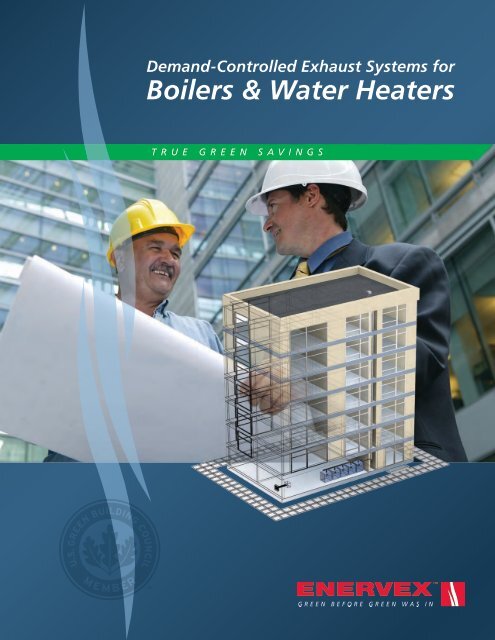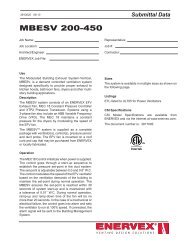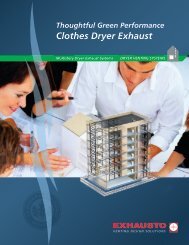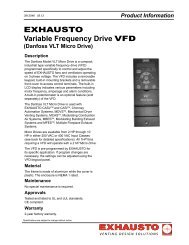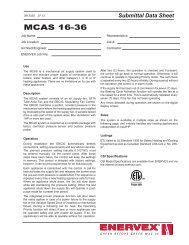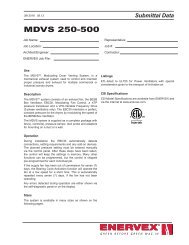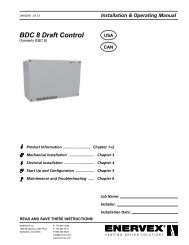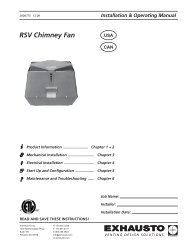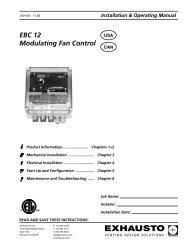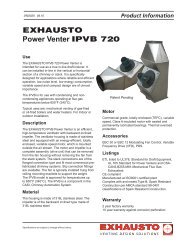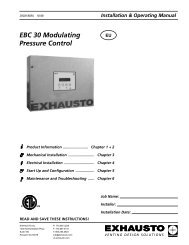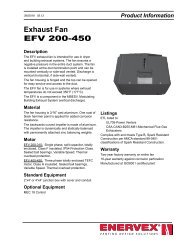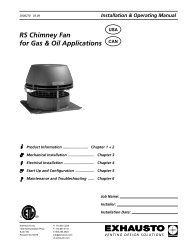Demand-controlled Exhaust Systems for Boilers and Water - Enervex
Demand-controlled Exhaust Systems for Boilers and Water - Enervex
Demand-controlled Exhaust Systems for Boilers and Water - Enervex
You also want an ePaper? Increase the reach of your titles
YUMPU automatically turns print PDFs into web optimized ePapers that Google loves.
<strong>Dem<strong>and</strong></strong>-Controlled <strong>Exhaust</strong> <strong>Systems</strong> <strong>for</strong><br />
<strong>Boilers</strong> & <strong>Water</strong> Heaters<br />
TRUE GREEN SAVINGS
ENERVEX Makes it Easy <strong>and</strong><br />
Economical to be Green<br />
2<br />
If the exhaust system <strong>for</strong> a heating appliance (boiler or water<br />
heaters) does not provide a precise draft <strong>for</strong> the combustion,<br />
it causes the appliance to run inefficiently. An inefficient boiler<br />
is not only more expensive to run, but it emits a higher level of<br />
emissions.<br />
ENERVEX’s dem<strong>and</strong><strong>controlled</strong> exhaust system is designed to<br />
optimize the operation of a heating system by maintaining a<br />
precise ration of fuel to air, which relies on proper air supply<br />
<strong>and</strong> chimney draft.<br />
A Design That Fits Every<br />
Type of Building<br />
Hotels/Resorts<br />
Offices<br />
Hospitals<br />
AIR<br />
Sports Arenas<br />
Schools/Colleges<br />
Museums<br />
Apartments/<br />
Condominiums<br />
With their air louvers <strong>and</strong> vent terminations, traditional heating<br />
appliance exhaust systems can take up a considerable amount<br />
of space, which impacts a building’s aesthetics. Also, some<br />
buildings are constructed in such a way that an optimal venting<br />
system seems impossible to install.<br />
ENERVEX’s dem<strong>and</strong><strong>controlled</strong> exhaust system offers a<br />
flexibility that other system can’t. Not only does it take up much<br />
less space, but because it’s not a gravitybased system, it allows<br />
the engineers to place the boilers where they are best suited.
How <strong>Dem<strong>and</strong></strong>-Controlled <strong>Exhaust</strong> Works<br />
In order to operate efficiently, a boiler must maximize heat<br />
transfer by maintaining the precise ratio of fuel to air, which<br />
relies on proper air supply <strong>and</strong> draft. Because many factors<br />
affect the draft, including the boiler operation <strong>and</strong> outdoor<br />
temperatures <strong>and</strong> elements, maintaining the appropriate level<br />
can be difficult. Too much or too little draft can cause flame<br />
rollouts or pilot light failures, as well as freezing pipes or<br />
drains in cold climates.<br />
A dem<strong>and</strong><strong>controlled</strong> exhaust system maintains a precise<br />
draft by constantly adjusting the exhaust rate to meet current<br />
dem<strong>and</strong>s. The following illustration describes the components<br />
<strong>and</strong> operation of a dem<strong>and</strong><strong>controlled</strong> exhaust system:<br />
The pressuredifferential sensor<br />
monitors pressure inside the main<br />
stack through a duct probe. It is<br />
powered by the controller <strong>and</strong><br />
provides the control signal to the<br />
controller. It can be installed in<br />
other locations depending on the<br />
application.<br />
Proper Draft is Crucial<br />
The constant pressure<br />
controller modulates the<br />
speed of the singlephase or<br />
threephase draft fan. It is<br />
<strong>for</strong> indoor installation only.<br />
Improper draft has a major impact on boiler operation. It’s not<br />
uncommon to see highefficiency boilers operating at lowefficiency<br />
levels. This is a result of inadequate draft control. A boiler’s draft<br />
range is often very narrow <strong>and</strong> draft control can be made difficult<br />
when multiple boilers are exhausted through a common chimney.<br />
3<br />
Insufficient<br />
draft<br />
Perfect<br />
draft<br />
Excessive<br />
draft<br />
The main stack can be<br />
straight up or have offsets,<br />
or it could run horizontally<br />
out through a side wall.<br />
The variable speed<br />
draft fan features a<br />
lowprofile design<br />
that is easily accessible.<br />
The constant pressure<br />
controller provides the<br />
power supply.<br />
Inline draft fans or overdraft<br />
dampers are usually installed<br />
in this location, be<strong>for</strong>e the<br />
exhaust enters the common<br />
vertical, but it can also be<br />
installed in the common<br />
vertical above the tee.<br />
Balancing baffles are often<br />
used to balance the draft<br />
between the appliances.<br />
The exhaust source is a<br />
heating appliance, which<br />
can be condensing or non<br />
condensing <strong>and</strong> can be a<br />
gravitydraft or a <strong>for</strong>ceddraft<br />
design.
Sustainable Advantages<br />
Economical<br />
ENERVEX <strong>Dem<strong>and</strong></strong>-Controlled<br />
Fan Cost Venting Material Space Cost Fan Operating Cost<br />
17,000 47,000 23,000 4,000<br />
Combined chimney w/o fan<br />
Venting Material Space Cost Cost of efficiency loss<br />
ECONOMICAL 68,000 40,000 75,000<br />
Multiple 250HP boilers - 4,000 hours/year - $1.20/Therm<br />
Life Cycle Cost (LLC) - 15 years, $1.20/Therm<br />
Multiple <strong>Boilers</strong> with EXHAUSTO<br />
415,000 Therms = $499,200 per boiler<br />
Over a 15year period a typical dem<strong>and</strong><strong>controlled</strong><br />
Multiple boilers exhaust using common system stackserving<br />
4 highefficiency<br />
434,000 Therms boilers = $520,800 in a per 20story boiler building costs<br />
50% less to operate than a combined system<br />
ENERGY without SAVINGS dem<strong>and</strong>control. Most of these<br />
savings are energy savings due to boiler ef<br />
Multiple 250HP boilers - 4,000 hours/year - $1.20/Therm<br />
ficiency improvements. And savings can be<br />
further enhanced by adding an Economizer.<br />
Multiple <strong>Boilers</strong> with EXHAUSTO<br />
415,000 Therms = $499,200 per boiler<br />
Material <strong>and</strong><br />
Labor Savings<br />
Multiple boilers using common stack<br />
434,000 Therms = $520,800 per boiler<br />
MATERIAL AND LABOR<br />
Venting of 4 high-efficiency boilers in 20-story building<br />
Combined sidewall<br />
venting with ENERVEX<br />
Combined Venting with ENERVEX<br />
Combined Venting<br />
$27,500<br />
$68,000<br />
Individual Venting $87,000<br />
ECONOMICAL<br />
$72,000<br />
Combining chimneys <strong>and</strong> reducing dia meters<br />
Life Cycle Cost (LLC) - 15 years, $1.20/Therm<br />
can save material <strong>and</strong> labor when using a<br />
mechanical draft system. Smaller chimneys<br />
are less expensive to install. Side wall exhaust<br />
can save even more material <strong>and</strong> labor.<br />
Fan Cost Venting Material Space Cost Fan Operating Cost<br />
17,000 47,000 23,000 4,000 EXHAUSTO <strong>Dem<strong>and</strong></strong>-Controlled<br />
Venting Material Space Cost Cost of efficiency loss<br />
68,000 40,000 75,000<br />
Energy Savings<br />
Multiple boilers using a common chimney<br />
operate at higher O 2 levels than when<br />
exhausted by individual chimneys.<br />
A mechanical draft system provides more<br />
precise draft control so the O 2 levels can<br />
be lowered. Annual savings can amount to<br />
24% <strong>and</strong> thous<strong>and</strong>s of Dollars. Adding an<br />
economizer will improve energy savings by<br />
up to 5%.<br />
1.0<br />
0.8<br />
0.6<br />
0.4<br />
0.2<br />
$ Fuel Cost<br />
Multiple 250HP boilers<br />
4000<br />
Common stack<br />
ENERVEX<br />
ENERVEX with Economizer<br />
Unmatched<br />
Per<strong>for</strong>mance<br />
Pressure (inWC) ENERVEX Other<br />
20 40 60 80 100 120 140 160 180 200 220 240 260 280<br />
Seconds<br />
Not only is the ENERVEX system<br />
fast in response to dem<strong>and</strong> changes,<br />
it’s also able to maintain a +/2% accuracy<br />
from setpoint. Alternative solutions using<br />
a VFD <strong>and</strong> a pressure sensor only achieve a<br />
+/ 20% accuracy, so their savings are over<br />
20% less than that of an ENERVEX system.<br />
Combined chimney w/o fan<br />
4<br />
$ 1.20 / Therm<br />
52,020<br />
per boiler<br />
49,920<br />
per boiler<br />
46,500<br />
per boiler<br />
Hours/Year
Space Saving<br />
Combining chimneys <strong>and</strong> reducing diameters can save building space. A smaller footprint<br />
could save as much as $15,000 worth of space in a 20story building. It also reduces clutter<br />
on the roof. Even more space can be saved if redirecting the chimney out through a sidewall.<br />
Aesthetics<br />
Today’s buildings are designed to be both functional <strong>and</strong> attractive. While the ENERVEX<br />
system provide great space savings, it can also keep chimney terminations out of sight.<br />
The same applies <strong>for</strong> combustion air supply where large outside gravity louvers or intakes can<br />
be replaced with small louvers when the combustion air supply is provided by an<br />
ENERVEX dem<strong>and</strong><strong>controlled</strong> air supply system.<br />
5
Chimney Automation System<br />
(CASV) - Termination<br />
Application<br />
The Chimney Automation System (CASV) is a dem<strong>and</strong><strong>controlled</strong><br />
exhaust system designed <strong>for</strong> commercial<br />
boilers <strong>and</strong> water heaters in buildings where the<br />
exhaust is powered by a chimney fan on<br />
the exterior of the building.<br />
The CASV system can<br />
be combined with a<br />
Modulating Combustion<br />
Airsupply System that<br />
provides combustion air<br />
to a mechanical room.<br />
A common EBC can<br />
control both systems<br />
independently.<br />
The <strong>for</strong>cedair louver, located<br />
on the building envelope, is<br />
substantially smaller than a<br />
gravity louver.<br />
Complete Code Compliance<br />
ENERVEX’s dem<strong>and</strong><strong>controlled</strong> exhaust systems comply with<br />
all national building codes <strong>and</strong> st<strong>and</strong>ards. In most cases a noncompliant<br />
venting installation can be brought into compliance<br />
by the addition of a mechanical draft system.<br />
6<br />
The air supply fan, which can<br />
be <strong>controlled</strong> by the EBC<br />
constant pressure controller,<br />
supplies combustion air at a<br />
dem<strong>and</strong><strong>controlled</strong> rate.<br />
The products of combustion<br />
are exhausted to the outdoors<br />
by a termination fan. The fan<br />
can be installed below the<br />
parapet <strong>for</strong> aesthetics.<br />
L E E D<br />
EA, MR,<br />
EQ, ID<br />
QUALIFIED<br />
ENERVEX SUSTAIN ABLE DESIG N<br />
The common vertical<br />
stack is typically located<br />
inside a firerated chase.<br />
The CASV system is<br />
designed to work with<br />
almost any type of heating<br />
appliance fueled by gas<br />
or oil.<br />
The EBC constant pressure<br />
controller is located inside<br />
the boiler room close to<br />
the boilers, which are interlocked<br />
with the controller.<br />
The end of the common<br />
manifold is often the<br />
optimal location of the<br />
probe <strong>and</strong> transducer.
Chimney Automation System<br />
(CASI) - Inline<br />
Application<br />
The Chimney Automation System (CASI) is a dem<strong>and</strong><strong>controlled</strong><br />
exhaust system designed <strong>for</strong> commercial<br />
boilers <strong>and</strong> water heaters in buildings where the exhaust is<br />
powered by a fan in the boiler room. This system<br />
is an option <strong>for</strong> tall buildings or a building that<br />
features sidewall ventilation.<br />
The CASI system can<br />
be combined with a<br />
Modulating Combustion<br />
Airsupply System that<br />
provides combustion air<br />
to a mechanical room.<br />
A common EBC can<br />
control both systems<br />
independently.<br />
The <strong>for</strong>ced air louver, located<br />
on the building envelope, is<br />
substantially smaller than a<br />
gravity louver.<br />
The air supply fan supplies combustion<br />
air at a dem<strong>and</strong><strong>controlled</strong> rate.<br />
The fan can be <strong>controlled</strong> by the EBC<br />
constant pressure controller.<br />
Add Value to the Building<br />
An ENERVEX system can add real value to a building. Through<br />
the energy savings generated via the improved boiler operating<br />
efficiency value is added by lowering the utility bill. Added<br />
value can be as much as six times the annual energy savings.<br />
Boiler maintenance cost is reduced while extending equipment<br />
life expectancy.<br />
7<br />
Vertical mounting. Can be<br />
installed at the bottom of the<br />
vertical <strong>for</strong> easy access.<br />
When an inline draft fan<br />
is used the chimney is<br />
often terminated with a<br />
stack cap.<br />
L E E D<br />
EA, MR,<br />
EQ, ID<br />
QUALIFIED<br />
ENERVEX SUSTAIN ABLE DESIG N<br />
The common vertical stack<br />
is typically located inside a<br />
firerated chase.<br />
The common vertical<br />
stack must be pressure<br />
tight when an inline<br />
draft fan is used.<br />
The CASI system is designed<br />
to work with virtually any<br />
type of heating appliance<br />
fueled by gas or oil.<br />
The EBC constant pressure<br />
controller is located inside<br />
the boiler room close to<br />
the boilers, which are interlocked<br />
with the controller.<br />
<strong>Exhaust</strong> is ventilated to<br />
the outdoors by a true<br />
inline fan installed in the<br />
boiler room.<br />
Horizontal mounting. Can be<br />
installed in the horizontal manifold<br />
<strong>for</strong> easy installation <strong>and</strong> access.
Modulating Over-Draft Damper<br />
(MODS)<br />
Application<br />
The Modulating OverDraft System (MODS) is a dem<strong>and</strong><strong>controlled</strong><br />
exhaust system that’s designed <strong>for</strong> buildings that<br />
experience excessive draft in the chimney, which<br />
impacts the ability of the heating system to<br />
operate efficiently.<br />
The MODS system can<br />
be combined with a<br />
CASV or CASI Chimney<br />
Automation System<br />
or/<strong>and</strong> a MCAS Modulating<br />
Combustion<br />
Airsupply System that<br />
provides combustion<br />
air to a mechanical<br />
room.<br />
The air supply fan, which can<br />
be <strong>controlled</strong> by the EBC<br />
constant pressure controller,<br />
supplies combustion air at a<br />
dem<strong>and</strong><strong>controlled</strong> rate.<br />
The <strong>for</strong>cedair louver,<br />
located on the building<br />
envelope, is substantially<br />
smaller than a gravity<br />
louver.<br />
Eliminate Large Air Louvers<br />
Combustion air supply louvers require a large amount of<br />
wall space <strong>and</strong> can compromise the aesthetics of a building.<br />
Although it may be impossible to eliminate them, a mechanical<br />
air supply system can reduce the louver size dramatically. This<br />
can also eliminate the risk <strong>for</strong> frozen water pipes <strong>and</strong> drains in<br />
cold climates.<br />
8<br />
The end of the common<br />
manifold is often the<br />
optimal location of the<br />
probe <strong>and</strong> transducer.<br />
<strong>Exhaust</strong> is ventilated to the outdoors<br />
with or without a draft fan. The fan<br />
may be needed <strong>for</strong> multiple boiler<br />
applications <strong>and</strong> can be installed<br />
below the parapet <strong>for</strong> aesthetics.<br />
The modulating multiblade<br />
damper is located<br />
in the horizontal manifold<br />
between the boiler<br />
<strong>and</strong> the vertical chimney.<br />
It is powered <strong>and</strong> <strong>controlled</strong><br />
by the EBC.<br />
The common vertical<br />
stack is typically located<br />
inside a firerated chase.<br />
L E E D<br />
EA, MR,<br />
EQ, ID<br />
QUALIFIED<br />
ENERVEX SUSTAIN ABLE DESIG N<br />
The modulating multiblade<br />
draft damper is located in<br />
the horizontal manifold<br />
between the first boiler <strong>and</strong><br />
the vertical stack<br />
The EBC constant pressure<br />
controller is interlocked with<br />
the boilers <strong>and</strong> is located<br />
close to them inside the<br />
boiler room.<br />
The MODS system is<br />
designed to work with<br />
almost any type of heating<br />
appliance fueled by<br />
gas or oil, but it’s mostly<br />
used with <strong>for</strong>ceddraft<br />
type of boilers.
IPVB-ECO Power Venter with<br />
Boiler Economizer<br />
Save Energy, Reduce Emissions<br />
The unique, patentpending IPVBECO Power Venter with integrated<br />
Boiler Economizer is designed <strong>for</strong> use with any boiler or<br />
water heater with round stacks. The combustion source can be<br />
any steam boiler or hot water boiler whether of atmopsheric or<br />
<strong>for</strong>ced draft design.<br />
For the first time, the IPVBECO allows atmospheric appliances<br />
to utilize a boiler economizer. The extremely compact economizer<br />
represents a substantial pressure loss in the stack system,<br />
but with the assistance of the IPVB power venter, the loss is<br />
negated <strong>and</strong> an EBC30/35 draft controller assures perfect draft<br />
at all times <strong>and</strong> thus perfect boiler operation.<br />
And a single economizer can h<strong>and</strong>le multiple boilers. There is<br />
no longer a need <strong>for</strong> individual boiler economizers in commonly<br />
vented boiler systems. Downsizing of the stack system is also<br />
possible.<br />
The power vented economizer is available in 7 “off the shell”<br />
sizes <strong>and</strong> can be installed on any size of boiler stack. It is also<br />
possible to downsize the chimney system <strong>for</strong> additional savings<br />
in space <strong>and</strong> materials.<br />
1. Vertical mounting.<br />
Can be installed<br />
at the bottom of<br />
the vertical <strong>for</strong><br />
easy access.<br />
Typical applications are: boiler feedwater, makeup water, hot<br />
water return, hot water storage tank, condensate tank, process<br />
water, potable water<br />
• Compact <strong>and</strong> highly efficient<br />
• A single IPVB-ECO economizer can h<strong>and</strong>le multiple appliances<br />
• Condensing or non-condensing<br />
• Natural gas or LP<br />
• Entering gas tempeatures: 300°F (150°C) to 700°F (370°C)<br />
• Ultra-quiet<br />
• Variable speed <strong>and</strong> direct drive<br />
• Copper or stainless steel fin-tubes<br />
• Simple installation<br />
• Mounting flanges <strong>for</strong> bolting to mating flanges or adapters<br />
2. Horizontal mounting.<br />
Can be installed in the<br />
horizontal manifold <strong>for</strong> easy<br />
installation <strong>and</strong> access.<br />
9<br />
3. Horizontal mounting.<br />
Can be installed in the<br />
horizontal manifold <strong>for</strong><br />
easy installation<br />
<strong>and</strong> access.<br />
Installation Inside<br />
– Vertically or Horizontally<br />
The patent pending design provides a great deal of flexibility.<br />
The IPVBECO can be installed in virtually any part of the<br />
chimney system because it is a true inline fan. It can be installed<br />
inside in the vertical section or the horizontal section<br />
of the chimney.<br />
It can also be installed just inside a wall <strong>for</strong> sidewall vented<br />
applications.
Redundancy <strong>for</strong> Critical Installations<br />
Extra Safety <strong>and</strong> Guaranteed Uptime<br />
Redundancy is critical in many applications such as hospitals<br />
<strong>and</strong> hotels – just to mention a couple. These are applications<br />
where possible downtime during repair, maintenance or system<br />
failure is not acceptable. Examples of other redundant systems<br />
are pumps, steam boilers, water heaters, generators etc.<br />
ENERVEX offers redundant mechanical draft systems, overdraft<br />
damper systems <strong>and</strong> combustion air supply systems<br />
– or a combination of all.<br />
A typical redundant mechanical draft system consists of two<br />
individually operated CASI, Chimney Automation <strong>Systems</strong>,<br />
where the inline IPVB Power Venters are installed in a serial<br />
or parallel configuration. Each system is individually powered<br />
<strong>and</strong> has its own EBC30 or 35 control, Variable Frequency<br />
Drive, <strong>and</strong> Pressure Sensor. One is designated the “Primary”<br />
<strong>and</strong> the other the “Secondary” systme.<br />
The two system are connected to an EBC25<br />
Redundancy Controller, which monitors the<br />
operation of both system. In case of a component<br />
failure, a general mechanical failure or an electrical<br />
failure, the EBC25 immediately switches the operation<br />
to the “Secondary” system while signaling the Building<br />
Management system <strong>and</strong>/or sending an audible alarm.<br />
Improve Boiler Room Safety with CO Monitoring<br />
For the Safety of Your Employees<br />
Boiler room safety is becoming increasingly important due to<br />
the number of accidents occuring every year.<br />
The EBC 35 Draft Control <strong>and</strong> CO Monitor is an easy way<br />
to safeproof your boiler facility. Installation is simple <strong>and</strong> the<br />
control can be interlocked with up to six (6) boilers in a st<strong>and</strong>ard<br />
configuration <strong>and</strong> a virtually unlimited number of boilers<br />
in a custom configuration.<br />
An integrated Proven Draft Switch function assures that if<br />
sufficient draft cannot be maintained, the control will lock<br />
out the boiler(s) within an adjustable time period.<br />
The CO transmitter with LCD display monitors CO levels<br />
on location <strong>and</strong> can be daisychained, if needed. The CO<br />
monitor meets OSHA <strong>and</strong> other safety requirements <strong>and</strong><br />
can be set specifically <strong>for</strong> the individual application. If a<br />
dangerously high CO level – or the pre predetermined<br />
max. level – is reached the control automatically locks out<br />
the boiler(s) within an adjustable time. Automatic reset<br />
avoids nuisance lockouts <strong>and</strong> the need <strong>for</strong> manual reset.<br />
The pressure sensor has dual pressure transducers <strong>for</strong> monitoring<br />
of safe sensor operation. Sensor failure generates<br />
an alarm <strong>and</strong> locks out appliance operation.<br />
10<br />
Serial Design<br />
Two IPVB power venters<br />
are installed in series<br />
The CO sensor(s) is mounted at<br />
a specified location <strong>and</strong> wired<br />
to the EBC35 controller. Sensors<br />
can be daisychained if more<br />
than one is needed.<br />
Parallel Design<br />
Two IPVB power venters<br />
are installed in parallel.<br />
The EBC35 control box<br />
is interlocked with the<br />
boilers. In situations with<br />
excessive CO levels the<br />
EBC35 shuts down the<br />
boiler operation.
All the Right Components<br />
RSV Chimney Fan<br />
EXSTREAM<br />
P E R F O R M A N C E<br />
D EVELOPED AND MANUFACTURED BY EXHAUSTO<br />
BESB Low Energy Supply Fan<br />
SFTA Supply Fan<br />
EXSTREAM<br />
P E R F O R M A N C E<br />
D EVELOPED AND MANUFACTURED BY EXHAUSTO<br />
• Rugged <strong>and</strong> compact design<br />
• High-efficiency aluminum centrifugal impeller<br />
• Made in cast aluminum <strong>for</strong> outdoor installation<br />
• Variable speed, direct drive, TEFC motor<br />
• 5 sizes available, ETL <strong>and</strong> ETLc listed to UL378<br />
RSV 200 RSV 250 RSV 315 RSV 400 RSV 450<br />
Power Supply VAC 1 x 120 (1x220240) 3x208240 / 3x380400<br />
Amperage Amp 1.4 (0.4) 2.9 (0.8) 5.8 (1.8) 3.5 / 2.1 6.5 / 3.8<br />
Motor Output HP (kW) 0.15 (0.1) 0.2 (0.16) 0.5 (0.35) 1.0 (0.75) 2.0 (1.5)<br />
RPM 1600 1720<br />
Weight Lbs (kg) 47 (18) 60 (26) 88 (35) 97 (44) 128 (58)<br />
Duct Connections Inch (mm) 8 (200) 10 (250) 12 (315) 16 (400) 16 (400)<br />
Max Capacity CFM (m 3 /h) 500 (850) 1,150 (1,955) 2,000 (3,400) 2,900 (4,930) 3,900 (6,630)<br />
• Low energy fan in compact design<br />
• High-efficiency aluminum centrifugal impeller<br />
• Made in corrosion resistant material <strong>for</strong> indoor <strong>and</strong> outdoor installation<br />
• Variable speed, direct drive, TEFC motor<br />
• 4 sizes available, ETL <strong>and</strong> ETLc listed to UL705<br />
• Tubeaxial fan in compact design<br />
• Steel housing <strong>and</strong> cast aluminum propeller<br />
• Variable speed, direct drive, TEFC motor<br />
• 6 sizes available, ETL <strong>and</strong> ETLc listed to UL705<br />
SFTA 16 SFTA 18 SFTA 21 SFTA 24 SFTA 30 SFTA 36<br />
Power Supply VAC 3x200240 OR 3x440480<br />
Amperage Amp 2.8 / 1.4 2.8 /1.4 4.0 / 2.0 8.2 / 4.1 14.2 / 7.1 23.0 / 11.5<br />
Motor Output HP (kW) 1.0 (0.75) 1.0 (0.75) 1.5 (1.3) 3.0 (2.25) 5.0 (3.75) 10.0 (7.5)<br />
RPM 1750<br />
Weight Lbs (kg) 53 (24) 60 (27) 85 (39) 97 (54) 149 (77) 234 (117)<br />
Duct Connections Inch (mm) 16 (400) 18 (450) 21 (530) 24 (600) 30 (750) 36 (910)<br />
Max Capacity CFM (m 3 /h) 4,000<br />
(6,800)<br />
BESB 250 BESB 250 BESB 315 BESB 400 BESB 500<br />
Power Supply VAC 1x120 1x220240 3x200240 / 3x400480<br />
Amperage Amp 5.8 2.9 3.1 / 1.7 6.5 / 2.9 9.0 / 4.0<br />
Motor Output HP (kW) 0.5 (0.35) 0.5 (0.35) 1.0 (0.75) 2.0 (1.5) 3.0 (2.25)<br />
RPM 1600 1400 1720 1720 1720<br />
Weight Lbs (kg) 70 (32) 70 (32) 84 (38) 132 (60) 170 (77)<br />
Duct Connections Inch (mm) 10 (250) 10 (250) 12 (315) 16 (400) 20 (500)<br />
Max Capacity CFM (m 3 /h) 1,500 (2,550) 1,200 (2,040) 2,400 (4,080) 4,300 (7,300) 5,800 (9,860)<br />
11<br />
5,000<br />
(8,500)<br />
7,000<br />
(11,900)<br />
11,000<br />
(18,700)<br />
17,000<br />
(28,900)<br />
31,000<br />
(52,700)
IPVB Power Venter<br />
EXSTREAM<br />
P E R F O R M A N C E<br />
D EVELOPED AND MANUFACTURED BY EXHAUSTO<br />
IPVB-ECO Power Venter with Economizer<br />
EXSTREAM<br />
P E R F O R M A N C E<br />
D EVELOPED AND MANUFACTURED BY EXHAUSTO<br />
• True inline exhaust fan in compact design<br />
• High-efficiency aluminum centrifugal impeller (stainless steel in 620-models)<br />
• Made in 316SS <strong>for</strong> indoor <strong>and</strong> outdoor installation<br />
• Variable speed, direct drive, TEFC motor<br />
• 7 sizes available, ETL <strong>and</strong> ETLc listed to UL378<br />
• True inline exhaust fan in compact design<br />
• High efficiency cast alu impeller (stainless steel in 620-models)<br />
• Made in 316SS<br />
• Variable speed, direct drive, TEFC motor<br />
• Economizer coil in copper or stainless steel<br />
• 7 sizes available, ETL <strong>and</strong> ETLc listed to UL378<br />
IPVB 6205ECO IPVB 6207ECO IPVB 62010ECO<br />
Power Supply VAC 3 x 400480<br />
Amperage Amp 7.5 11.3 15.0<br />
Motor Output HP (kW) 5.0 (3.7) 7.5 (5.6) 10.0 (7.4)<br />
RPM 1,350 (45) 1,500 (51) 1,740 (60)<br />
Weight Lbs (kg)<br />
IPVB 300 IPVB 300 IPVB 350 IPVB 400 IPVB 500<br />
Power Supply VAC 1x120 1x220240 3x200240 / 3x400480<br />
Amperage Amp 5.8 2.9 3.1 / 1.7 6.5 / 2.9 9.0 / 4.0<br />
Motor Output HP (kW) 0.5 (0.35) 0.5 (0.35) 1.0 (0.75) 2.0 (1.5) 3.0 (2.25)<br />
RPM 1600 1400 1720 1720 1720<br />
Weight Lbs (kg) 34 (75) 34 (75) 43 (94) 58 (128) 83 (183)<br />
Duct Connections Inch (mm) 12 (300) 12 (300) 14 (350) 16 (400) 20 (500)<br />
Max Capacity CFM (m 3 /h) 1,350 (2,300) 1,200 (2,000) 1,200 (2,000) 3,600 (6,100) 5,400 (8,700)<br />
IPVB 300 IPVB 300 IPVB 350 IPVB 400 IPVB 500<br />
Power Supply VAC 1x120 1x220240 3x200240 / 3x400480<br />
Amperage Amp 5.8 2.9 3.1 / 1.7 6.5 / 2.9 9.0 / 4.0<br />
Motor Output HP (kW) 0.5 (0.35) 0.5 (0.35) 1.0 (0.75) 2.0 (1.5) 3.0 (2.25)<br />
RPM 1600 1400 1720 1720 1720<br />
Weight Lbs (kg) 34 (75) 34 (75) 43 (94) 58 (128) 83 (183<br />
Duct Connections Inch (mm) 12 (300) 12 (300) 14 (350) 16 (400) 20 (500)<br />
Max Capacity CFM (m 3 /h) 1,000 (1,700) 890 (1,510) 1,750 (2,975) 3,000 (5,100) 4,750 (8,000)<br />
Max MBH * (kW) 2,000 (580) 1,800 (530) 3,500 (1,000) 6,000 (1,750) 9,000 (2,600)<br />
Duct Connections Inch (mm) 24 (610)<br />
IPVB 6205 IPVB 6207 IPVB 62010<br />
Power Supply VAC 3x400480<br />
Amperage Amp 7.5 11.3 15.0<br />
Motor Output HP (kW) 5.0 (3.7) 7.5 (5.6) 10.0 (7.4)<br />
Max RPM (Hz) 1,350 (45) 1,500 (51) 1,740 (60)<br />
Weight Lbs (kg) 434 (240) 434 (240) 444 (202)<br />
Duct Connections Inch (mm) 24 (610)<br />
Max Capacity CFM (m 3 /h) 10,000 (17,000) 11,500 (19,500) 13,500 (22,900)<br />
Max Capacity CFM (m 3 /h) 9,000 (15,000) 10,000 (17,000) 12,000 (20,500)<br />
Max MBH * (kW) 18,000 (5,275) 20,000 (5,860) 24,000 (7,000)<br />
* Depending on boiler type<br />
12
EBC30 Modulating Pressure Controller<br />
EBC35 Draft <strong>and</strong> CO Safety Controller<br />
MicroVLT Variable Frequency Drive<br />
MDF Modulating Damper Control<br />
• Constant pressure fan speed controller <strong>for</strong> fan or ventilator<br />
• Used with single, modulating heating appliance<br />
• Provides 0-10V or 10-120V signal<br />
• ETL <strong>and</strong> ETLc listed<br />
Power Supply VAC (Hz) 1x120 (60Hz) / 1x240 (5060Hz)<br />
Amperage Amp 6.3 / 3.15<br />
Operating Temperature °F (°C) 4 to 104 (20 to 50)<br />
Range of Operation In WC (Pa) 00.6 (0150)<br />
Output VAC 10120 / 20240<br />
VDC 010<br />
Weight Lbs (kg) 3.0 (1.5)<br />
• Constant monitoring of CO-level <strong>and</strong> draft<br />
• Can be used as constant pressure fan speed controller as the EBC 30<br />
• Used with single, modulating heating appliance<br />
• Provides 0-10V or 10-120V signal<br />
• ETL <strong>and</strong> ETLc listed<br />
• With CO monitoring<br />
Power Supply VAC (Hz) 1x120 (60Hz) / 1x240 (5060Hz)<br />
Amperage Amp 6.3 / 3.15<br />
Operating Temperature °F (°C) 4 to 104 (20 to 50)<br />
Range of Operation In WC (Pa) 00.6 (0150)<br />
Output VAC 10120 / 20240<br />
VDC 010<br />
Relays 2<br />
Range ppm 0125<br />
Response time seconds < 60<br />
Weight Lbs (kg) 3.0 (1.5)<br />
• Variable speed drive <strong>for</strong> use with 3-phase fans <strong>and</strong> power venters<br />
• Pre-programmed from factory – no field programming needed<br />
• Available <strong>for</strong> 200-240VAC <strong>and</strong> 400-480VAC<br />
• Multiblade damper in 304 stainless steel (316SS available)<br />
• Stainless steel shaft <strong>and</strong> bearings<br />
• Fast-acting damper motor with brushless DC motor<br />
• Operating temperatures up to 750°F (400°C)<br />
• Equipped with EnerDrive failsafe system<br />
• 16 sizes available<br />
13
ENERVEX Success Stories<br />
Burj Khalifa Tower<br />
Formerly known as Burj Dubai Tower, this tower was designed by Skidmore, Owings <strong>and</strong> Merrill in Chicago.<br />
The mixeduse tower features the world’s first Armani Hotel Dubai <strong>and</strong> Armani Residences, alongside corporate<br />
suites, residences, retail <strong>and</strong> leisure facilities, Burj Khalifa Tower is at the centre of Downtown Burj Dubai,<br />
a 500acre megadevelopment by Emaar Properties.<br />
At 828 metres (2,716 feet), the Burj Khalifa has already achieved the distinction of being the world’s tallest<br />
structure.<br />
ENERVEX designed <strong>and</strong> supplied six (6)dem<strong>and</strong><strong>controlled</strong> inline mechanical draft systems <strong>for</strong> the building’s<br />
water heaters <strong>and</strong> steam boilers. The many heating appliances are exhausted via six chimney flues each with<br />
an integrated RSIB mechanical draft system. The chimney flues are mostly running horizontally through the<br />
building <strong>and</strong> terminate to the outside via sidewalls <strong>and</strong> through the ground <strong>for</strong> aesthetics.<br />
The mechanical draft systems also provide some ventilation to the mechanical room by maintain an air exhaust<br />
rate while controlling the chimney flue draft as well as the combustion air intake.<br />
Heinz Stadium<br />
Venting the heating appliances<br />
at a sports facility is always a<br />
challenge, as was the case with<br />
Heinz Field in Pittsburgh, PA.<br />
The stadium featured a field<br />
heating system <strong>and</strong> domestic<br />
water heaters, which ran both<br />
horizontally <strong>and</strong> vertically, along<br />
with many elbows.<br />
ENERVEX’s venting system included a dem<strong>and</strong> <strong>controlled</strong> mechanical<br />
draft system. The eight Thermal Solution EVH2000 boilers are<br />
vented with a ENERVEX CASV dem<strong>and</strong><strong>controlled</strong> mechanical draft<br />
system. The domestic water heating system is using a venting system<br />
that includes a CASV4502 dem<strong>and</strong> <strong>controlled</strong> mechanical draft system.<br />
The system controls the draft of the two A.O. Smith 4,000MBH<br />
domestic water heaters. In addition, two water heaters on the<br />
concourse levels are vented with two CASV dem<strong>and</strong> <strong>controlled</strong><br />
mechanical draft systems.<br />
14<br />
Lutheran<br />
General Hospital<br />
OWP/P <strong>and</strong> CannonDesign<br />
recently completed a new US$201<br />
million, eightstorey patient care<br />
tower <strong>for</strong> Advocate Lutheran General<br />
Hospital in Park Ridge, IL. The<br />
192bed facility, designed to the<br />
highest st<strong>and</strong>ards of patient <strong>and</strong><br />
staff safety <strong>and</strong> environmental<br />
sustainability, is the first hospital in<br />
Illinois expected to achieve LEED<br />
Gold certification <strong>and</strong> will be one<br />
of a h<strong>and</strong>ful in the country with<br />
this designation. Sustainability was<br />
pinned as a key objective from<br />
conception <strong>and</strong> as a result, the building’s mechanical <strong>and</strong> electrical<br />
systems will reduce energy use by 21 percent.<br />
The heating system consisted of two banks of Aerco Benchmark 3.0<br />
boilers with seven (7) <strong>and</strong> eight (8) boilers respectively, exhausted<br />
by redundant ENERVEX Chimney Automation <strong>Systems</strong>. Due to long<br />
horizontal <strong>and</strong> vertical chimney sections with many elbows, the<br />
mechanical draft system is needed in order <strong>for</strong> the boilers to operate<br />
at their rated efficiency.<br />
Being a critical part of the hospital’s HVAC system, it was imperative<br />
that the mechanical draft system was of a redundant design, <strong>and</strong><br />
ENERVEX is known as one of the few experts in the mechanical draft<br />
field. The installed system consists of two (2) redundant systems<br />
– one <strong>for</strong> each bank of boilers. Each system consists of two RSIB<br />
Power Venters with modulating overdraft dampers <strong>and</strong> a redundant<br />
control system with redundant VFD’s, EBC 30 Modulating Draft Controls<br />
<strong>and</strong> logics <strong>for</strong> switching between the two redundant systems in<br />
case of a component failure.<br />
In addition to providing perfect draft so the boilers operate efficiently,<br />
the system design assures that if any component – fan,<br />
damper, VFD, EBC30, pressure sensor etc. – fails, then it automatically<br />
switches to a redundant component while alarming the building<br />
management system.
Georgia Aquarium<br />
The Georgia Aquarium, which opened in November of 2005, is one of<br />
the largest aquariums in the world, featuring more than 55,000 fish<br />
from approximately 500 species <strong>and</strong> an estimated 8 million gallons of<br />
fresh <strong>and</strong> saltwater. With a project of this magnitude, it’s critical that<br />
the boiler system that heats the water operates efficiently with the<br />
appropriate ventilation. To ensure this, the developers opted to install a<br />
dem<strong>and</strong><strong>controlled</strong> ENERVEX<br />
mechanical draft system.<br />
Because the boiler system is<br />
located under the parking<br />
structure, the fans are installed<br />
in an enclosed casing, out of<br />
sight, on the top of the parking<br />
building.<br />
The Westin Diplomat Resort & Spa<br />
A project that literally st<strong>and</strong>s out is the “Diplomat Hotel” in Ft.<br />
Lauderdale, FL<br />
The hotel’s main heating plant was originally located across Highway<br />
A1A on the west side. It originally of a dual Kewanee boiler system<br />
that supplied the resort across the street through underground<br />
pipes. In recent years the pipes had started leaking <strong>and</strong> repairs were<br />
estimated to run into the millions of dollars.<br />
A new boiler system was designed on the 4th floor of the parking<br />
garage on the east side of Hwy A1A where the hotel property is located.<br />
The new system consists of 11 Hydrotherm KN20 2,000 MBtu<br />
High Efficiency condensing boilers.<br />
Since it was not practical to design af vertical flue system, if was<br />
decided to exhaust horizontally. However, the owner didn’t want to<br />
see a 22 inch pipe out in front of the building.<br />
It was decided to design a dual mechanical draft system that<br />
included two RSIB500 Power Venters <strong>and</strong> venting through AL294c<br />
venting systems.<br />
The system has a continuous loop drawing air from the outside<br />
<strong>and</strong> feeding all the direct air intakes <strong>for</strong> the boilers. It continues by<br />
making a 180 loop <strong>and</strong> then it picks up the exhaust of each boiler,<br />
<strong>and</strong> ultimately tie into the dual RSIB500. They exhaust to the outside<br />
through a plenum with a decorative louver. This hides the termination<br />
<strong>and</strong> makes it aesthetically pleasing.<br />
15<br />
Khalidiya Palace<br />
Rayhaan by Rotana<br />
This is the first property to open in<br />
Abu Dhabi under Rayhaan Hotels &<br />
Resorts by Rotana br<strong>and</strong>. The 5 star<br />
property offers 443 splendid rooms<br />
<strong>and</strong> suites with their modern design<br />
complementing the values of the<br />
contemporary Arabian culture.<br />
The hotel’s laundry facility is served<br />
by three BIB Cochran Wee Chieftain steam boilers. The original<br />
design called <strong>for</strong> individual venting of the boilers with 16 inch<br />
chimney flue, but long horizontal runs <strong>and</strong> space restraints made<br />
this impossible.<br />
The chimney flue was redesigned by ENERVEX <strong>and</strong> all three boilers<br />
were connected to a common 20 inch chimney flue powered by a<br />
CASI Chimney Automation System <strong>and</strong> an IPVB 500 inline power<br />
venter. The chimney flue was reduced from a common 30 inch to a<br />
20 inch diameter. The discharge is located in a small housing right<br />
above the entry to the garage (see picture to the left).<br />
The installation saved valuable space as well as chimney flue material.<br />
It was estimated that the total material savings including the<br />
Chimney Automation System exceeded US$10,000.
ENERVEX<br />
– Made By Experience<br />
ENERVEX combines quality components, superior technology<br />
<strong>and</strong> experienced personnel to deliver a system that is economical,<br />
environmentally sustainable, aesthetically pleasing <strong>and</strong><br />
reliable. In addition, our custom engineering <strong>and</strong> space saving<br />
design ensure that the project meets code requirements, as<br />
well as the high st<strong>and</strong>ards of today’s builders. At ENERVEX, we<br />
don’t build a onesizefitsall venting system. We underst<strong>and</strong><br />
that each project is unique <strong>and</strong> our threestep process allows us<br />
to design a venting system that meets the specific requirements<br />
of a given job.<br />
The ENERVEX Per<strong>for</strong>mance Guarantee<br />
Because ENERVEX designs the entire venting system, we<br />
take full responsibility <strong>for</strong> its operation. Contact ENERVEX<br />
<strong>for</strong> details.<br />
The ENERVEX Process<br />
1. Pre-sales analysis<br />
This phase allows us to gather requirements<br />
<strong>and</strong> create a customized sizing<br />
report.<br />
ENERVEX Inc.<br />
1200 Northmeadow Pkwy.<br />
Suite 180<br />
Roswell, GA 30076<br />
USA<br />
2. System design<br />
Using our FanCalc software, our<br />
engineers design a system that takes<br />
into consideration proper vent type<br />
application, operating temperatures,<br />
pressure losses <strong>and</strong> the risk of condensation.<br />
It also provides specific wiring<br />
diagrams.<br />
ENERVEX <strong>and</strong> LEED<br />
P: 770.587.3238<br />
F: 770.587.4731<br />
T: 800.255.2923<br />
info@enervex.com<br />
www.enervex.com<br />
The FanCalc Difference<br />
One of the many things that set ENERVEX apart from our<br />
competitors is our proprietary design software, FanCalc.<br />
FanCalc allows our engineers to quickly <strong>and</strong> accurately design<br />
a venting system because it contains extensive boiler <strong>and</strong> water<br />
heater data, such as operating <strong>and</strong> exhaust requirements,<br />
exhaust temperatures, efficiency, ducts with kvalues, resistance<br />
factors, insulation factors <strong>and</strong> more. Instead of spending days or<br />
weeks analyzing data, our engineers can enter the in<strong>for</strong>mation<br />
into FanCalc <strong>and</strong> receive a report that provides the appropriate<br />
sizing in<strong>for</strong>mation, code violation warnings <strong>and</strong> even design<br />
alternatives.<br />
3. Engineering <strong>and</strong> installation<br />
support<br />
Every ENERVEX system comes<br />
complete with jobspecific AutoCAD<br />
installation instructions <strong>and</strong> wiring<br />
diagrams. Our engineering support<br />
teams have access to these files <strong>and</strong><br />
are available to answer any questions<br />
that come up during installation.<br />
ENERVEX’s systems qualify <strong>for</strong> LEED points under the Energy & Atmosphere (EA),<br />
Materials & Resources (MR), Indoor Environmental Quality (EQ) <strong>and</strong> Innovation &<br />
Design Process (ID) sections. ENERVEX has actively promoted lowenergy installations,<br />
energy savings, indoor air quality <strong>and</strong> recycling <strong>for</strong> decades – long be<strong>for</strong>e it became<br />
“in”. For years ENERVEX has been involved in the European legislation processes <strong>and</strong><br />
has been a member of United States Green Building Council (USGBC) since 2005.<br />
Unlike most manufacturers we didn’t have to come up with ”new” GREEN solutions<br />
– we have made them <strong>for</strong> decades!<br />
3911005 01.11


